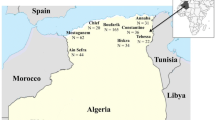Abstract
An anonymous honey bee locus, detectedpreviously with a cloned probe, has HhaI RFLP allelesspecific to African bees or common to both African andEuropean bees. To facilitate identification of thesealleles, this region, 1231, was made analyzable with thePCR. The two halves of the region, excluding thetermini, were amplified as two overlapping segments.Restriction sites were mapped, and the site differences responsible for the allelic RFLP patterns weredetermined. In the first half of the region, twopolymorphic HhaI sites are present in the commonalleles, whereas one, the other, or both of the sitesare absent in the African alleles. In the secondhalf, a third polymorphic HhaI site is present or absentin both common and African alleles. A short part of thesecond half of the region, including more of the terminus, was amplified as a third segment.Within this segment, close to this terminus, a fourthpolymorphic HhaI site is absent in some Africanalleles.
Similar content being viewed by others
REFERENCES
Hall, H. G. (1986). DNA differences found between Africanized and European honeybees. Proc. Natl. Acad. Sci. USA 83:4874.
Hall, H. G. (1990). Parental analysis of introgressive hybridization between African and European honeybees using nuclear DNA RFLPs. Genetics 125:611.
Hall, H. G. (1991). Genetic characterization of honey bees through DNA analysis. In Spivak, M., Breed, M., and Fletcher, D. J. C. (eds.), The “African” Honey Bee, Westview Press, Boulder, CO, pp. 45–73.
Hall, H. G. (1992a). Processes of New World African honeybee spread revealed by DNA studies. Fla. Entomol. 75:51.
Hall, H. G. (1992b). Further characterization of nuclear DNA RFLP markers that distinguish African and European honeybees. Arch. Insect Biochem. Physiol. 19:163.
Hall, H. G. (1995). Restriction fragment length polymorphism (RFLP) analyses: Distinguishing African and European honeybees. In Clapp, J. P. (ed.), Molecular Methods for Species Identification, Methods in Molecular Biology, Vol. 50, Humana Press, pp. 333–366.
Hall, H. G., and McMichael, M. A. (1992). European honey bee (Apis mellifera L.) (Hymenoptera: Apidae) colonies at high elevations in Costa Rica tested for African DNA markers. Bee Sci. 2:25.
McMichael, M., and Hall, H. G. (1996). DNA RFLPs at a highly polymorphic locus distinguish European and African subspecies of the honey bee, Apis mellifera L. and suggest geographical origins of New World honey bees. Mol. Ecol. 5:403.
Saiki, R. K., Gelfand, D. H., Stoffel, S., Scharf, S. J., Higuchi, R., and Horn, G. T. (1988). Primer-directed enzymatic amplification of DNA with a thermostable DNA polymerase. Science 239:487.
Sambrook, J., Fritsch, E. F., and Maniatis, T. (1989). Molecular Cloning. A Laboratory Manual, 2nd ed., Cold Spring Harbor Laboratory Press, Cold Spring Harbor, NY.
Schaffer, H. E., and Sederoff, R. R. (1981). Improved estimation of DNA fragment lengths from agarose gels. Anal. Biochem. 115:113.
Rights and permissions
About this article
Cite this article
Hall, H.G. PCR Amplification of a Locus with RFLP Alleles Specific to African Honey Bees. Biochem Genet 36, 351–361 (1998). https://doi.org/10.1023/A:1018797429804
Issue Date:
DOI: https://doi.org/10.1023/A:1018797429804




